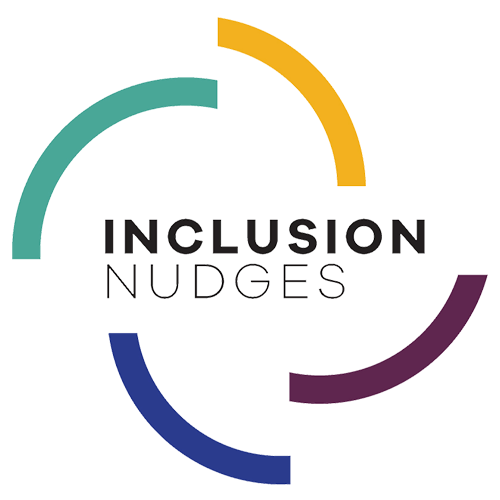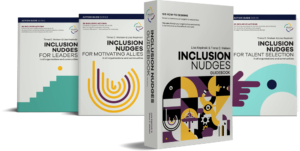Gratitude boosts well-being, social connection, and sense of belonging. There are many ways to practice gratitude more purposefully in our personal lives, so what about in our work lives and how can this support creating a culture of inclusive actions? Here are some ways we can integrate gratitude for inclusion at work.
What is gratitude?
Gratitude is the expression of thankfulness of ourselves and of the people, experiences, and things in our life. Research has shown that gratitude is reinforced by our DNA, evolved human behaviours, cognitive system, culture, and socialisation structures. The benefits of expressing appreciation have been well-studied with findings of boosts in our psychological, social, and physical health. Gratitude also increases empathy and perspective taking which are fundamental skills for acting inclusively. And a sense of connection and belonging are heightened when we recognize others and express our appreciation of them.
Yet with all the positive associations of gratitude, it is usually happening by serendipity rather than purposefulness. The emotional experience of gratitude often catches us by surprise, triggered by a powerful impromptu realisation or stimulus. It can also be prompted by a reoccurring event, holiday, or a meaningful date in the calendar. Embracing opportunities for reflective moments of what we are appreciative of in ourselves and in our lives can be a way to more regularly have the benefits of gratitude. There are many actions that we can do to support gratitude in our personal lives. But what about ways that we can purposefully design for gratitude in our work lives?
Gratitude at work
With changes in the workplace, such as experienced due to the pandemic, there are often emotions of fear, anxiety, stress, and disengagement. Faced with that, there is an even more urgent need for gratitude. Receiving gratitude helps employees feel supported and connected to the organisation’s purpose and their colleagues. The reassurance provided by being appreciated helps with focus and performance. This is something that everyone needs, not just the ‘top talents’ or those who are in the familiar ‘in group’ of people. What if all workers in an organisation felt they were essential and valued employees? Imagine the feeling of that! By pausing, noticing, and expressing gratitude to our colleagues and employees, we all have the ability to make this happen. The power of an appreciative ‘thank you’ can positively transform people and the ways that they work together. And as such, gratitude needs to be an integrated standard for how we interact and communicate, and also how we select, assess, and empower people.
To focus on increasing the expression of gratitude at work, we encourage starting with a staff-wide reflective inquiry. Then, integrate targeted designs to support gratitude within the processes and systems to make gratitude easier to do at work. Here are some ways to do this, based on our work with many organisations.
Gratitude as a cultural norm
Engage leaders and staff in a reflective review on how is gratitude currently practiced in the organisation and how all would like it to happen going forward. Consider asking questions such as these. “How is gratitude a part of our organisational values—both the formal and the informal values? How does gratitude show up (the specific behaviour)? How do we inspire and enable people to express gratitude? Is gratitude part of our skills competency model? Do we develop, select, assess, and promote people who put gratitude into practice?” Hearing from people in the organisation on the current state and the desired future state, then this can help target what actions to take to support gratitude becoming a cultural norm. Like other skills, such as empathy, listening, perspective-taking, and humble leadership, gratitude should be embedded in talent selection, performance assessments, and development initiatives. Inclusion Nudges support doing inclusive gratitude.
Inclusive gratitude as part of talent selection
In your interview process, build in a question on gratitude, such as, a past-experience question like “How have you expressed gratitude towards work colleagues in the past?”. Or craft a scenario-based question, for example, “Imagine your team has just achieved a major project milestone. This involved everyone on the team, each person contributing in their own way, but which you may not have had full visibility to exactly who did what. How would you go about recognition?”. Make gratitude a part of the hiring qualifications in a systematic way. For inspiration on how to do this process design, read the Inclusion Nudge called “Structured Scoring of 6 Qualifications” in The Inclusion Nudges Guidebook and also in the Inclusion Nudges for Talent Selection.
Gratitude for inclusion work in performance assessments
Most organisations express a desire to have an inclusive culture, but few have integrated gratitude for those who do this. Efforts that employees do for diversity, equity, and inclusion initiatives frequently go unnoticed, or are assumed to be extra to their primary job role. As a result, it can feel that managers don’t value the contributions that staff do. When this is not integrated into the employee performance appraisal process, this perpetuates an under-valuing and under-recognition of the work on creating an inclusive work environment. To ensure that employees’ contributions to an organisation’s inclusion initiative are recognised and discussed as a default and norm, then build a prompter question within the performance appraisal process, such as “In addition to your formal objectives, identify contributions you have done to make our workplace more inclusive.” Learn more about this Inclusion Nudge called “Valuing Staff Contributions for Inclusive Culture” in The Inclusion Nudges Guidebook, and also in the Inclusion Nudges for Leaders and in the Inclusion Nudges for Talent Selection.
Gratitude prompters for inclusive behaviours
Gratitude can be expressed by taking the time to say what you noticed and valued that someone did. Yet all too often at work, we are going at such a fast pace that we don’t do this. The result is that the positive uplift of that feedback is not received—neither for the person who gives the appreciation nor the person who receives it, and also not on the wider organisations. However, we can apply a simple design of prompter questions to create time for noticing and expressing gratitude. The use of prompters can be very useful in shift strong social norms and hidden patterns which may not be supporting gratitude and inclusion. An example of prompter questions are “What’s are we doing well to be more inclusive in how we work? Who’s doing this well and how are they doing this?”. Ask this in the spirit of gratitude and learning new behaviours that are inclusive. Integrate prompter questions into project reviews and other meetings. Another prompter design is to make it easy for peer-to-peer expressions of gratitude for inclusive behaviours. One company did this by providing ready-made ‘postcards of appreciation’ (both physical and online versions) that started off with the message of “I saw you being inclusive when you did this ___.” This made it easy to do the act of expressing gratitude and it was tied to the company’s initiative to recognise people who were role models of the behavioural norms desired in the culture (inclusion was one of those desired behaviours).
We have several Inclusion Nudges based on prompters. For more inspiration on this approach, read “Prompters to Connect & Increase Belonging” in The Inclusion Nudges Guidebook, and also in the Inclusion Nudges for Leaders.
Get access to more designs to achieve your diversity, equity, & inclusion initiatives
By applying Inclusion Nudges, you can more effectively achieve your diversity, equity, & inclusion initiatives. Inclusion Nudges make it easy to do this in a way that that engages all people and results in them being more motivated to take action. The research studies and the designs referenced in this article are described in step-by-step details in the Inclusion Nudges Guidebook, and also in the books in the Action Guide series. We encourage you to try applying the change methodology of Inclusion Nudges, and adapting the designs to your context. Inclusion Nudges make inclusion the norm everywhere, for everyone, and by everyone.







